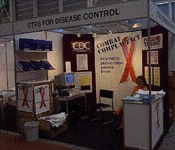 |

|
| | ||
|
| Compiled by Badpuppy's GayToday From CDC Reports Geneva - As the U.S. nears completion of the second decade in the AIDS epidemic, one of the greatest challenges will be combating complacency in HIV prevention, according to the Centers for Disease Control and Prevention (CDC). In a media briefing on the eve of the 12th World AIDS Conference, Helene Gayle, M.D., M.P.H., Director of CDC's National Center for HIV, STD, and TB Prevention, spoke of the tremendous progress made to date in both prevention and treatment, but cautioned that despite a tendency to declare victory, the epidemic is far from over, and the U.S. may face unexpected challenges as a result of recent advances in treatment. "While the tendency may be to relax in the assurance that we've made remarkable progress in a very short time, the danger of complacency is perhaps greater than ever before," said Gayle. "This epidemic is far from over."
CDC researchers also presented their most effective prevention programs for meeting these challenges, as well as new evidence that prevention not only saves lives but also saves money, especially with the rising costs of treatment.
Communities of Color Dramatically Affected Gayle examined the latest trends in the epidemic, demonstrating that the illusion of a receding epidemic is far from the reality for many populations, especially communities of color. Over the last decade, AIDS incidence has increased most dramatically among African-American and Hispanic women infected through heterosexual sex and injection drug use. The toll among men of color has also increased, with gay and bisexual risk and drug-related risk contributing relatively evenly to AIDS cases in African-American and Hispanic men. "Combating complacency in the United States is made more difficult by the fact that the epidemic has settled among populations too often forgotten," stressed Gayle, "Yet the nation's success or failure in the next era of HIV prevention will be judged by our ability to mobilize and address this challenge." As the nation strives to extend effective HIV prevention programs to all populations at risk, Gayle points to a number of new challenges that must be faced.
Increasing Number of People Living With HIV The great success that many people have had with new combination therapies, and the resulting decline in the number of new AIDS cases and deaths, are indeed good news. Many infected individuals are leading longer and healthier lives. Yet, it is critical that this success not lull people into a sense of complacency about the need to protect themselves from infection. Gayle unveiled the latest data indicating continued declines in AIDS cases and deaths, and the resulting increase in the number of people living with HIV (HIV prevalence). "The underlying reality is that with increased prevalence of HIV comes an increased need for prevention." said Gayle. "For individuals at risk, increased HIV prevalence means each risk behavior carries an increased risk of infection." Potential Impact of Lessening Concern According to Gayle, CDC has already seen some indications of relaxed attitudes and increased risk among gay men -- particularly young gay men. Recent CDC qualitative research findings suggest that there is a lessening sense of urgency about the epidemic among gay and bisexual men overall, and some individuals report practicing safer sex less consistently. While not widespread, a minority of gay and bisexual men in group discussions report that either they or their peers are taking increased risks because of the more hopeful environment around AIDS. CDC believes it is critical to communicate that treatment advances do not negate the need for prevention. "Individuals at risk must understand that despite treatment advances, HIV remains a serious and preventable disease." Said Gayle. "If we focus on preventing infection, people will not have to undergo difficult and costly treatment."
Continued Evidence of Risk: Need to Focus on Uninfected and Infected In addition to reaching populations at high risk of infection, communities must design prevention services to reach HIV-infected populations. Research presented in Geneva found evidence of continued risk among both uninfected and infected populations. On a population basis, national survey data indicate that as many as 5 million adults (or 3.5%) are at high behavioral risk for infection. A 1996 household survey finds that 1.2 percent of the population reports drug-related risk and nearly 3 percent report sexual risk behaviors. And because this is a household survey, it likely underestimates the true level of risk.
Need for Integrated Treatment and Prevention Strategies HIV-infected individuals require a wide range of services to stay healthy and to maintain safe behaviors to prevent the spread of disease to others. Strategies to help individuals adhere to complex treatment regimens are urgently needed. For HIV-positive individuals to have the best chance of staying healthy, they must begin treatment early and take multiple medications as prescribed. The potential dangers of non-adherence are serious, both for the health of infected individuals and for the future spread of the epidemic. "If people miss doses of their medication, they may be at increased risk for developing drug-resistant strains of HIV," said Gayle. "If these strains are transmitted to others and spread widely, treatment progress to date could be lost." Gayle stresses the need to integrate behavioral strategies with biomedical solutions. "We live in a society that tends to think more readily about finding medical cures than maintaining healthy behaviors. But the truth is, medical solutions cannot work by themselves. Medical and behavioral strategies have to work together to make a difference," stressed Gayle.
Pay Attention to Prevention The good news, according to Gayle, is that we face these challenges with more knowledge than ever before about what biomedical and behavioral approaches work best in HIV prevention. CDC research to be presented in Geneva documented that behavioral interventions, if well designed, can significantly reduce risks. The challenge is applying this knowledge to design even more effective tools for prevention and to extend successes to all populations. "While we can't count how many thousands of infections have been prevented, we do know that HIV prevention has helped move us from a period of rapid growth to an overall stabilization in the U.S. We also know that 40,000 new infections each year is far too many. If we continue to pay attention to prevention, we can and must do better." |

 Gayle concludes that the U.S. may become a victim of its own success, if the country does not acknowledge the need to increase prevention efforts in emerging populations at risk, and to face a number of dangers that have emerged. Gayle believes if we relax prevention efforts either on a national or on an individual level, progress to date could be reversed. The body of prevention research presented by CDC at the 12th World AIDS Conference in Geneva, June 28-July 3, has examined many of these dangers, including increased HIV prevalence, the possibility of relaxed preventive behaviors among groups at risk, continued evidence of risk among both HIV-infected and at-risk populations, and the danger of emerging drug resistance.
Gayle concludes that the U.S. may become a victim of its own success, if the country does not acknowledge the need to increase prevention efforts in emerging populations at risk, and to face a number of dangers that have emerged. Gayle believes if we relax prevention efforts either on a national or on an individual level, progress to date could be reversed. The body of prevention research presented by CDC at the 12th World AIDS Conference in Geneva, June 28-July 3, has examined many of these dangers, including increased HIV prevalence, the possibility of relaxed preventive behaviors among groups at risk, continued evidence of risk among both HIV-infected and at-risk populations, and the danger of emerging drug resistance.
 Another recent CDC study indicates that some HIV-infected gay men in San Francisco and New York are continuing to engage in risky behaviors. Although the majority of HIV-infected men in this study perceived themselves as having a responsibility to protect others from HIV, just over 20 percent reported engaging in unprotected sex with an HIV-negative partner or partner of unknown serostatus in the past year. Findings indicate that those who perceive a personal responsibility for preventing the spread of HIV are much more likely to practice safer sex. It is clear that HIV-infected individuals need quality prevention counseling and on-going support to adapt and maintain safer sex behaviors.
Another recent CDC study indicates that some HIV-infected gay men in San Francisco and New York are continuing to engage in risky behaviors. Although the majority of HIV-infected men in this study perceived themselves as having a responsibility to protect others from HIV, just over 20 percent reported engaging in unprotected sex with an HIV-negative partner or partner of unknown serostatus in the past year. Findings indicate that those who perceive a personal responsibility for preventing the spread of HIV are much more likely to practice safer sex. It is clear that HIV-infected individuals need quality prevention counseling and on-going support to adapt and maintain safer sex behaviors.
